William Optics Zenithstar 61 APO Review
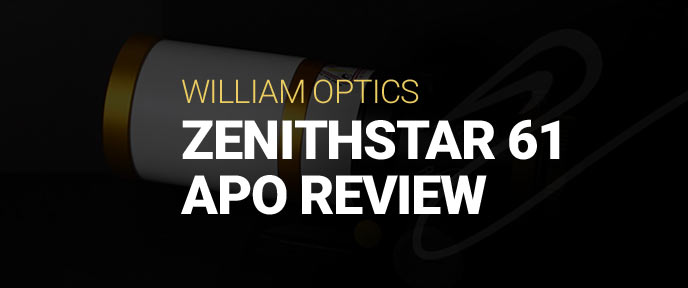
The William Optics Zenithstar 61 is a doublet apochromatic refractor telescope that excels in deep-sky DSLR astrophotography. The Z61 is the most portable telescope ever made by William Optics, a company with a reputation for building beautiful astrophotography refractors.
In this review, I’ll tell you why I think the William Optics Zenithstar 61 is a top contender when it comes to affordable astrophotography telescopes. I’ll cover the features and specs of the scope, and share some examples of deep-sky images taken using this refractor.
You can order the William Optics Z61 in 3 colors to better match your imaging setup.
Whether you use this telescope visually, or for deep sky astrophotography with a DSLR camera, you’ll be pleasantly surprised at the performance of a telescope at this size. The small size of this telescope keeps it affordable, while also providing wide-field views of the night sky.
This APO is currently on loan from the manufacturer, but after a few imaging sessions – I think this may have to become a permanent member of my astrophotography equipment. Aside from being a great portable option, The Z61 would make also great primary imaging refractor for anyone just starting out.
If you haven’t seen my review of the Radian Raptor 61, that is another compact refractor worth checking out.
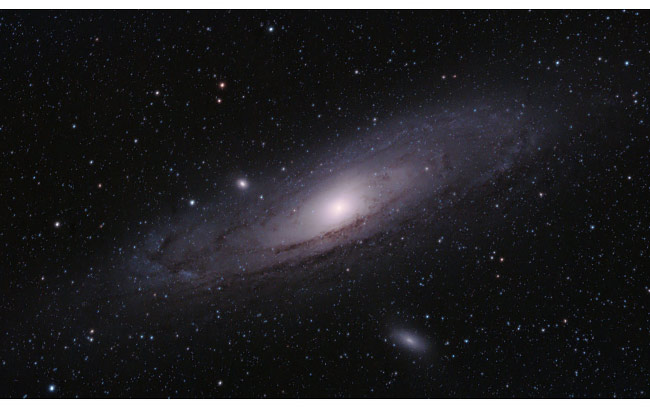
The image above was produced by stacking 72 x 2 minutes exposures using a Canon Rebel T3i Camera, and the Zenithstar 61 APO. The Z61 was mounted to an iOptron SkyGuider Pro Mount, and the camera was controlled using a remote shutter release cable.
Choosing your first telescope to use for DSLR astrophotography can be a difficult process. One thing I can’t stress enough is the benefits of portability and ease of use. A larger telescope may capture more light, but it will also be harder to manage, and much more demanding on your autoguiding and Polar alignment.
Z61 APO Doublet Telescope Specs
- Aperture: 61mm
- Focal Ratio: F/5.9
- Focal Length: 360mm
- Objective Lens: Synthetic Flourite FPL-53
- Focuser: 2″ 10:1 Dual-Speed
- Tube Weight: 3.2 Pounds
- Dedicated Field Flattener: Flat61
- Back Focus: Z61 Spacing Diagram
The Z61 is so compact and lightweight, I often set it up in the backyard for a spur of the moment imaging session using the iOptron SkyGuider Pro. The photo above was taken from my light-polluted backyard of the Heart Nebula.
William Optics Zenithstar 61 Review
Please watch my video review of this capable little astrophotography telescope. This will give you a closer look at the features and attention to detail that make the William Optics Z61 so special.
The Z61 was built to last. Early owners of the Zenithstar have praised William Optics for the attention to detail and finish of this scope. The Z61 includes inspection badges throughout, to remind you that this instrument has been tested before arriving in your hands.
The quality of this instrument is also experienced when taking a closer look at the paint and coatings covering the OTA. The color-matched dovetail plate included with my order has a beautiful gold finish. You can tell the team at William Optics takes great pride in their products.
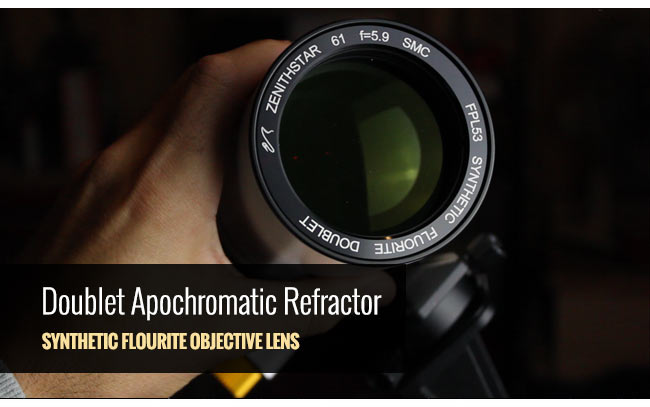
Synthetic Flourite for Superb Color Correction
The impressive optical quality of this apochromatic telescope is due to the FPL-53 glass used. FPL-53 is as close as you can get to pure fluorite, which means that your astrophotography images will display excellent color correction, with colorful, sharp stars. This glass is used in the objective lens and is known as Synthetic Flourite.
FPL-53 is the same glass used in the Meade 70mm Quadruplet Astrograph. Once you get accustomed to astrophotography images of this quality, it is hard to switch from an ED refractor to other telescope designs.
Looking for more examples of imaging refractors? Please review my top 5 astrophotography telescopes for beginners.
Features of the William Optics Z61
Smooth and Accurate Focus
This telescope excels at wide-field, deep sky astrophotography with a DSLR. The buttery smooth dual speed locking focuser means that your images will be razor-sharp. If you have ever struggled to find focus using a loose rack and pinions-style focuser, you will certainly appreciate the precision 1:10 speed micro focuser on the Z61.
Whether you use a Bahtinov mask to focus using Astro Photography Tool or Backyard EOS, or simply using the 10X Live View function of your DSLR, the precision focusing of the Z61 will ensure that your image is as sharp as possible.
Balanced and Secure
Because the Z61 is so compact and solid, balancing the scope is extremely easy to accomplish. You won’t find a hint of wobbliness while imaging the night sky with the Z61. The DSLR and telescope are rock solid united as one – very similar to a high-end telephoto camera lens.
Fast Optics with a Wide Field of View
Thanks to its fast optics (F/5.9), this refractor collects a lot of light in a short period of time. Image exposures of 2-3 minutes at ISO 1600 are likely all you will need to capture deep details of your target.
If you have ever struggled with framing up a large target such as the North America Nebula or Andromeda Galaxy, the Z61 is a breath of fresh air. The ultra-wide 360mm focal length means collecting photons on HUGE areas of the night sky in a single frame.
Even with a crop sensor camera like my Canon T3i/600D, the focal length of 576mm is still more than wide enough for the big targets.
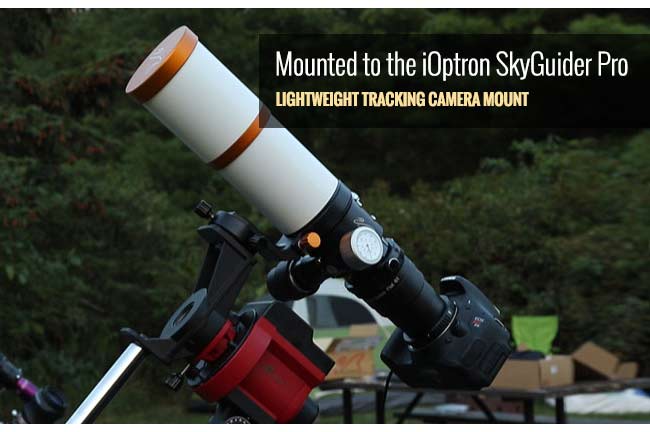
Highly portable and Lightweight
A high-quality refractor of this size is the perfect travel scope. When combined with a portable camera mount, you’ve got a very capable deep-sky imaging rig that can pack up into a backpack or travel container.
A collapsible carbon fiber tripod, the iOptron SkyGuider Pro, and the Z61 is probably the most portable deep sky astrophotography setup I have ever seen.
Deep Sky Imaging with the Zenithstar 61 APO
I brought the Zenithstar 61 with me last month on a camping trip to a dark sky site. Needless to say, the Z61 did not disappoint, as I was able to capture a new portrait of the Andromeda galaxy using my DSLR and a simple remote shutter release cable. No autoguiding or camera control software was used to capture my image of the Andromeda Galaxy.
If you are new to deep-sky astrophotography but have dabbled in tracked night sky shots including the Milky Way – this is likely the best possible next step for you. Never have I had such a painless first experience with a new telescope.
The reason I got away without using autoguiding, was due to a precise polar alignment, and the forgiving wide field of view in the Z61. Under a higher magnification telescope, there would be some slight star trailing in the image frames. My image included several
My image final image included 72 x 2-minute exposures and was processed in Adobe Photoshop. Below is a single 2-minute exposure, straight out of the camera. The image has not been edited or cropped.
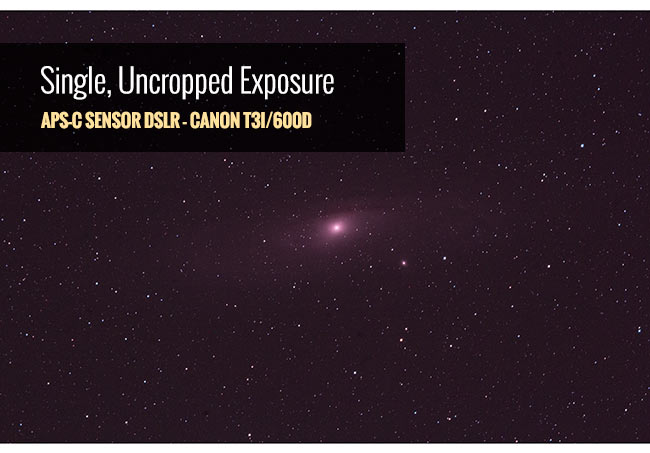
Using a Full Frame DSLR with the Z61
What about full-frame DSLR cameras such as the Canon EOS 6D or 5D Mark III? Well, I am currently looking into purchasing a full-frame DSLR (Modified 6D), so I can provide better reviews of upcoming telescopes for DSLR astrophotography. With that being said, here is what you can expect using a full-frame camera with the William Optics Z61 APO:
These photos have not been cropped. You can clearly see the effectiveness of the Flat61 field flattener when in use with a full-frame camera. I will put this to the test myself in a future post.
Images by James Yang using a full-frame Canon 6D and the Zenithstar 61 APO
An Affordable Imaging Refractor
The William Optics Zenithstar 61 currently retails for $398 USD. The price includes the telescope only, as you can add a number of extras to your order. This includes everything from a color-matched dovetail plate to the photo adapter for your DSLR camera.
I didn’t require a dovetail plate right away, as I was able to mount the built-in rotatable L-bracket to my iOptron SkyGuider Pro. The photo adapter mount for my Canon DSLR was a must, so it’s worth remembering this extra cost when pricing it out.
Z61 Accessories and Add-Ons
- Flat61 for Z61 (Field Flattener)
- Canon EOS T-Mount (48mm)
- Matching Color Dovetail Plate
- Matching Color Rotolock Adapter
- 2″ Durabright Carbon Fiber Plate
- 2″ Photo Adapter for Canon
- Solar Light Filter
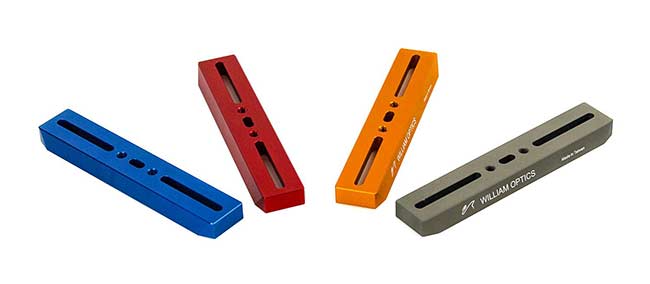
Flat61 Field Flattener
William Optics lists the Flat 61 for Z61 as a recommended accessory for this telescope, and I recommend that you get one too. The Flat61 was designed to be a perfect match for the F/5.9 focal ratio of this telescope, meaning that your images will remain crisp to the edge of the field.
This is an extra expense, with the Flat61 retailing for about $170 USD. Pretty steep when compared to the price of the telescope itself. The good news is, you don’t need the Flat61 right away, as long as you are okay with cropping your images to about 85% (Crop sensor DSLR) when processing.
You can connect your DSLR via the included 1.25″ Rotolock adapter (available in color-matched version), or invest in the larger 2″ Rotolock M54 pictured below. The 2″ Rotolocks pictured below matches the gold accents of my Zenithstar.
The 2″ Rotolock M54 for the Z61
This is a great option if you are looking to use the Z61 for visual observations using a diagonal and eyepiece. I really appreciate the thought that goes into the design of William Optics products. Owners pride themselves on having gear that not only works brilliantly but also looks good doing it. It’s hard to find a telescope manufacturer that pays more attention to aesthetics than William Optics.
The new versions of the Z61 Doublet include a built-in Bahtinov focusing mask, which is so handy when focusing your camera through the telescope.
Final Thoughts
I was thoroughly impressed with the fit and finish of the Z61 right away. The functionality of this telescope matches its attractive exterior. The portability and precision focuser make the Zenithstar 61 a pleasure to use, both at home and while traveling.
View my complete portable deep sky astrophotography kit
The high-end optics of this doublet become quite evident when reviewing images taken through the Z61. At 360mm, the focal length using a full-frame or crop-sensor DSLR camera is ideal for large deep-sky objects.
In September 2017, I photographed the Heart Nebula from my backyard using the Z61. This target is another great example of the FOV you can expect in the Zenithstar using an APS-C sensor DSLR camera.
All things considered – the Zenithstar 61 APO is a steal at $398. However, factoring the cost of the additional accessories will bring you back to reality. With that being said, I dare you to find a complete telescope package that can compete with the beautiful Z61.
View More Image Examples using the Z61: William Optics on Instagram
Related Posts:

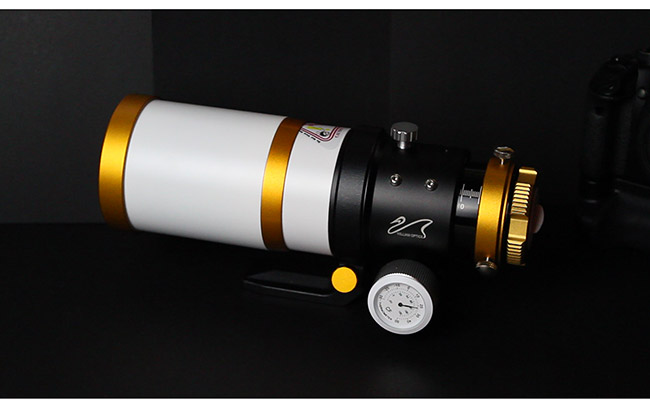
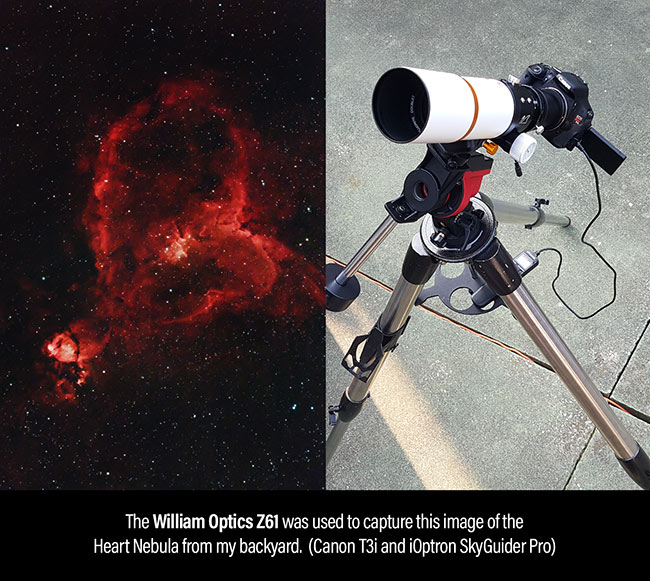


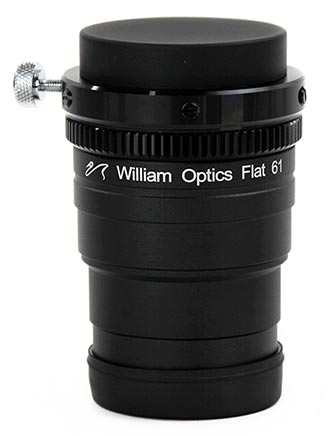


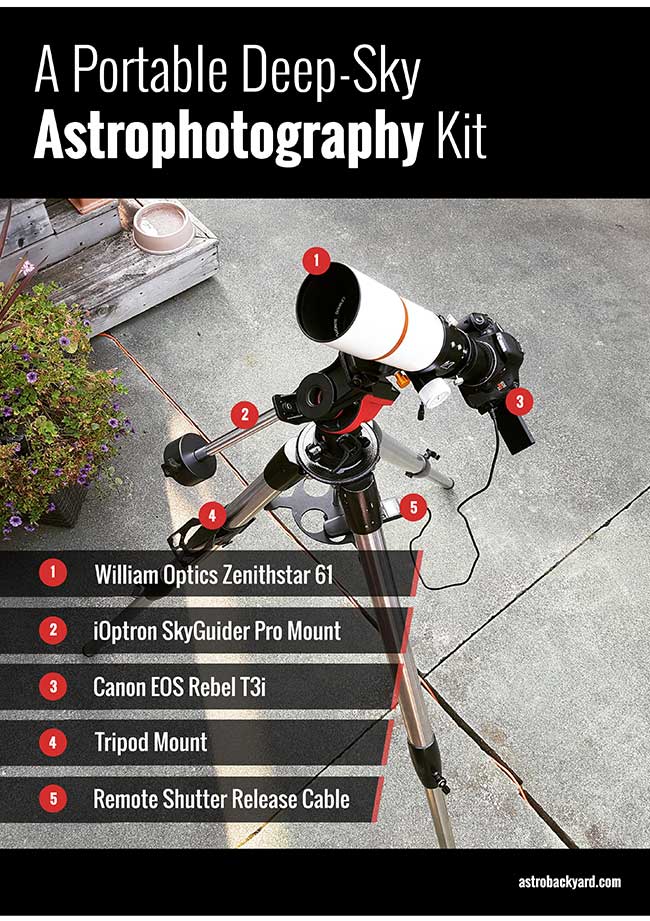
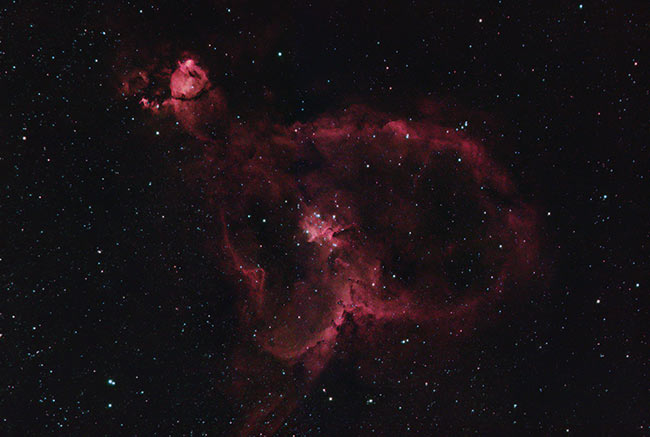

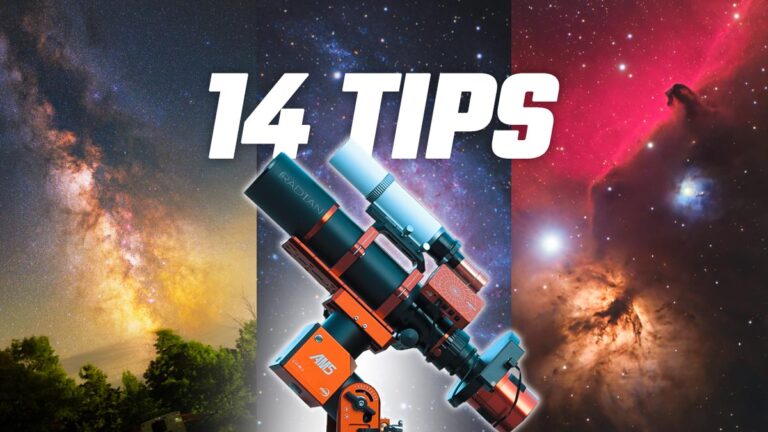

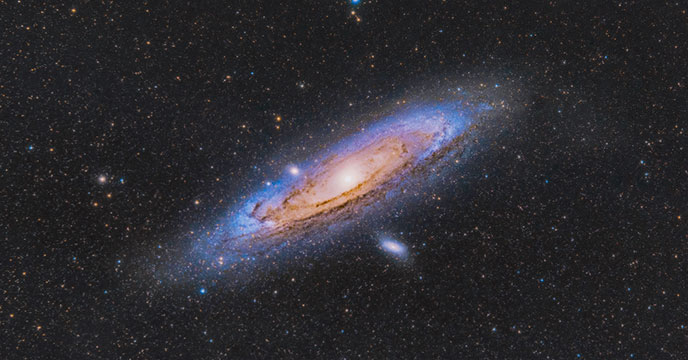
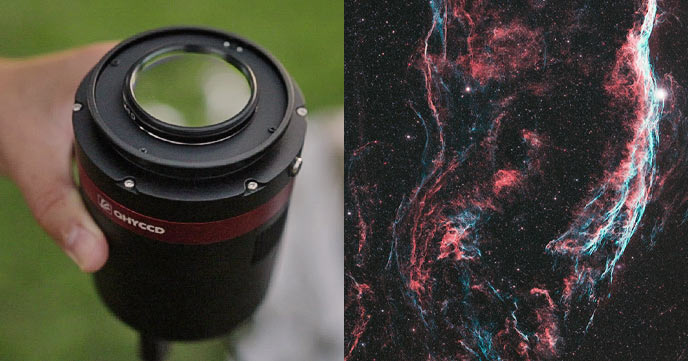

Hi Trevor, I was very pleased with your review of the William Optics Zenith Star 61. This is just what I have been looking for. Before I make the purchase I would like to see an un-cropped full frame photo, processed or unprocessed, comparing an image using the recommend field flattener to an image without the field flattener. I need to know if this scope will fill my needs from the components that comes in the box. Do you have these images for me to view from your collection or could you point me to where I can find them? Thanks for your help. Charles
Hi C. White,
Did Trevor reply to your request for information ? I have this same equipment and a full frame camera (Canon 6D) and I asked Trevor about a problem I had.
No Frank, I have not heard from Trevor. He is so busy doing so many things for us he just doesn’t have the time to respond to all of our questions and I understand. I did order and just received my ZS61. I am in the process of assembly and testing. It really looks good and I am pleased with it. Clouds and rain are keeping me from the good part. Trevor did an excellent review on the ZS61. I will comment here soon and will try to answer the question.
Hi Charles and Frank – sorry for the delay. I was hoping to have a good answer before responding. I simply don’t have a full-frame DSLR to test the Z61. I am looking to invest in a modified 6D – as I’d be able to provide better reviews/information to the many full-frame shooters out there. However – I know that James Yang has taken some amazing full frame shots with the Z61: https://www.astrobin.com/311921/?nc=all
Thanks Trevor for pointing out the link to James Yang on astrobin. The ZenithStar 61 is a small scope but it sure has a lot to offer.
Hi Trevor, Maybe you can verify this for me. My ZS 61 as it comes in the box has a
1 1/4 inch adapter attached to it. However it was not designed to be used as it is. You need some of the accessories to make it useful. For example, if you insert a 1 1/4 inch eyepiece into the adapter it will not reach focus until the eyepiece is about 3 inches out of the adapter. If you get a hollow tube eyepiece extender or adapter to reach focus it will work but the image will be reversed. This is not always desirable and I don’t think WO sells this extender. What you need is a 45 or 90 degree diagonal which by itself will add the 3 inches and it will reach focus and the image will be upright. The recommended accessory is the field flattener and a WO camera adapter. My Canon 40D works great with this configuration. WO just answered my email and said that the field flattener is only for imaging not visual and the diagonal is for visual. If this is true, and I am imaging high and can’t use the diagonal with my camera I have to lay on the ground to see camera live view. This means I would need to use a laptop computer and not the diagonal. What I am gathering with all this is that if you want to go visual then get a diagonal. If you want to image get the flattener. Any way, you are going to have to re configure the connecting pieces. How am I doing Trevor? Feel free to straighten me out.
Some thing else I just thought of Trevor. WO has a .pdf downloadable manual for the ZS 61 which shows an Accessory Map. You are supposed to view this map an see how you configure your scope. Am I the only one having trouble using this map?
Trevor, Here is a question I would like you to answer not just for me but for other followers as well. My camera, like all cameras, comes from the factory with an IR blocking filter to render normal daylight pictures as pleasing to the eye. These cameras are not as useful for Astro imaging as they could be because a red part of the image is filtered out. So we have to use an H-alpha filter to get all of the detail in the red nebula. My question is, can you compensate in Photoshop or Lightroom for not having the H-alpha filter when using an un modified camera?
Colleagues, maybe this is my request is not relevant, please report the outer diameter of the focuser Zenithstar 61 APO
Out of sheer curiosity, for a mostly portable setup for a beginner, would you recommend this, or the Zenithstar 73? I’m asking as there’s not much of a cost difference between the two (all of $110 CAD or so for just the telescope on Ontario Telescopes)
I’m an instant fan of your blog, and I’m now starting to seriously consider options for astrophotography options. I’m 95% sure to start with the iOptron Skyguider Pro, and likely the ZenithStar 61, mainly based on your recommendations. But I do have some questions: considering the range of William Optics Zenithstars, which would you recommend for which purpose/target objects? And secondly: is there any sense in attaching Barlows between the telescope and the camera?
Hi Trevor, nice review.
Can I attach a 2″ threaded filter inside of the Flat61 in order to use a ZWO ASI294 with the Z61 APO?
Thanks!
Hi Trevor!
Your review was very helpful in helping my select my own very first telescope which happens to be the Z61!
I am super new to all of this and am learning as much as I can. My main goal is to do astrophotography. I already had a Nikon D80 (which I will eventually upgrade), and next would be to get the field flattener and a mount, I am torn between the HEQ5 Pro and the EQ6-R Pro. (I am already looking toward the future and want a mount that I can use as I upgrade)and of course a dew zapper.
Aside from those items I would also like to use this scope for visual observations and am wondering what I would really need to get that set up? I am thinking I likely will be able to afford these before the full set up so I can at least start getting familiar with how it operates. I sit necessary to have the 2″ Rotolock, a diagonal AND an eyepiece?
Do you have any recommendations on the either of these? I have been trying to research what type of eyepiece I need but it’s just all so new to me!
Thank you!
I purchased the ZS61 in Nov 2019 as a travel scope and for occasional wildlife viewing. So far it has been excellent. Outstanding fit & finish and low magnification viewing.
However, the 2019 version does not include a 2″ x 1 1/4″ Rotolock, instead just a very nicely made 2″ x 1 1/4″ eyepiece holder with a brass collar and 2 thumbscrews.
A minor complaint is that the protective cap for the 10×1 focus knob falls off frequently. The felt lining intended to hold the cap in place is too thin to be effective.
Love your vids and reviews, would love to see something comparing this scope to the RedCat51. Have only found a few other people asking the same question, but no real answers.
Hi Trevor
I have placed an order for ZS 61 today, together with the ZS, adjustable ZS 61 Field Flattener.
I have a T3I and I am looking forward to using the scope on my Star Adventurer. You’re review was very helpful.
Thank you for all your reviews and posts. I am a big fan of your blog and your youtube videos. May I ask you what would you recommend between a redcat and a zenistar 61 for a star adventurer since you have used both of them for some time now?
Thanks a lot.
Thank you for your review, If you were new to astrophotography and choosing your very first imaging scope to use on a sky guider with an old unmodified canon dslr and had a limited budget, would you choose this and its field flattener or the Redcat51?
Sadly the raptor is out of my budget, and its unlikely ill ever be able to afford another scope after this so would love to make the best choice now. I’m really most interested in taking images of larger nebulae and some galaxies, I know the field of view will be large but hopefully I can crop down a little if I can gather enough data.
Thank you for rekindling my interest in photography and all things Astro, I’m just so glad to have come across your channels!